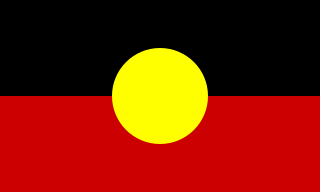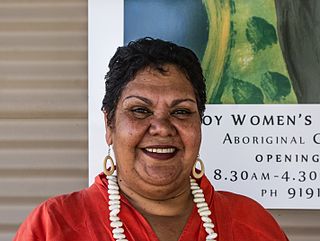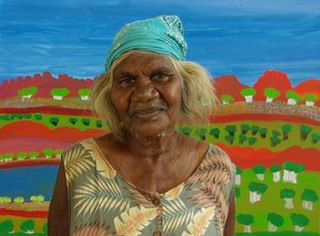Awards
| Ceremony | Category | Result |
|---|---|---|
| AACTA Awards | Best Documentary Under One Hour | Won |
| AACTA Awards | Best Cinematography in a Documentary | Nominated |
| AACTA Awards | Best Sound in a Documentary | Nominated |
| Jandamarra's War | |
|---|---|
| Written by | Mitch Torres |
| Directed by | Mitch Torres |
| Country of origin | Australia |
| Original language | English |
| Production | |
| Producers | Andrew Ogilvie Andrea Quesnelle Eileen Torres |
| Cinematography | Allan Collins Jim Frater Rusty Geller |
| Editor | Lawrie Silvestrin |
| Running time | 55 minutes |
| Release | |
| Original release |
|
Jandamarra's War is a 2011 Australian drama style documentary that tells the story of Jandamarra, a famous Aboriginal Australian warrior of the Bunuba people from Western Australia.
Jandamarra's War begins by detailing Jandamarra's early years, starting with his birth in 1873 and he and his mother Jinny's relocation when he was around the age of seven where he looked after cattle at the station at Lennard River Flats, for safety at a time when European colonists were frequently killing Aboriginal Australians. As a teenager, he left the cattle station with his Uncle Ellemarra to be initiated in Bunuba Law, but when they are caught spearing sheep both are sent to prison. After he left prison, he was expelled from Bunuba society for sleeping with other men's women and soon after he became friends with a policeman named Richardson. Later he killed Richardson, marking the beginning of his three-year war against the Europeans.
In 1894, Jandamarra led a rebellion against invading European pastoralists in order to defend Bunuba land and culture.
Jandamarra spent the last few years of his life hiding in his spirit country, Djumbud. His incredible ability to outwit police officers lead many to believe he had magical powers and many pastoralists left the Kimberley area for fear of him. His life ended when he was shot dead by Mungo Micki, an Aboriginal tracker. [1] [2] [3] [4]
Director and scriptwriter Mitch Torres wanted the film to portray the story of Jandamarra as accurately as possible, noting that:
Outsiders often misrepresent Jandamarra as an outlaw. I learnt that the reasons he fought the settlers were more complicated. The Bunuba wanted the real story told and I wanted to make a film that was inspired by those who are very proud of this warrior. A legend was born with Jandamarra’s death that remains etched in the minds of those who make up today’s Bunuba community. For them, he wasn’t a criminal; he was a resistance fighter and a hero.
In writing the script, I discovered Jandamarra was a product of a very traumatic period in the settlement of North Western Australia. He was very young when he rebelled against the settlers who had raised him in the ways of the white man. He was also somebody who was before his time, a philosopher, a tough but very intelligent man, who saw his world falling down around him and who wanted to do something about it, even though it would lead to an early death. I wanted to make a film that depicted Jandamarra not only as a hero who fought the cruelties and injustices suffered by his people at the hands of the settlers, but also as somebody who was very human.
Principal filming took place over ten days in June 2010 and most of the film's scenes were shot on Bunuba land in locations close to where the historical events being reenacted actually occurred. [6]
Jim Schembri wrote in The Age that "historical documentaries are at their best when they illuminate a little known narrative rather than merely recite a famous one. Hopefully, it will only be a matter of time before some wily filmmakers seize on the potential to develop Jandamarra's story into a full-blown feature film". [1]
| Ceremony | Category | Result |
|---|---|---|
| AACTA Awards | Best Documentary Under One Hour | Won |
| AACTA Awards | Best Cinematography in a Documentary | Nominated |
| AACTA Awards | Best Sound in a Documentary | Nominated |

Indigenous Australian art includes art made by Aboriginal Australian and Torres Strait Islander peoples, including collaborations with others. It includes works in a wide range of media including painting on leaves, bark painting, wood carving, rock carving, watercolour painting, sculpting, ceremonial clothing and sand painting; art by Indigenous Australians that pre-dates European colonisation by thousands of years, up to the present day.

The Australian Aboriginal Flag represents Aboriginal Australians. It is one of the officially proclaimed flags of Australia, by which it has special legal and political status together with the national flag and the Torres Strait Islander Flag, with which it is often flown.

Pemulwuy was a Bidjigal man of the Eora nation, born around 1750 in the area of Botany Bay in New South Wales, Australia. One of the most famous Aboriginal resistance fighters in the colonial era, he is noted for his resistance to European colonisation which began with the arrival of the First Fleet in January 1788.

Edward Joseph Egan is an Australian folk musician and a former public servant who served as Administrator of the Northern Territory from 2003 to 2007.
Jandamarra or Tjandamurra, known to European settlers as Pigeon, was an Aboriginal Australian man of the Bunuba people who led one of many organised armed insurrections against the European colonisation of Australia. Initially employed as a tracker for the police, he became a fugitive when he was forced to capture his own people. He led a three-year campaign against police and European settlers, achieving legendary status for his hit and run tactics and his abilities to hide and disappear. Jandamarra was eventually killed by another tracker at Tunnel Creek on 1 April 1897. His body was buried by his family at the Napier Range, where it was placed inside a boab tree. Jandamarra's life has been the subject of two novels, Ion Idriess's Outlaws of the Leopold (1952) and Mudrooroo's Long Live Sandawarra (1972), a non-fiction account based on oral tradition, Jandamurra and the Bunuba Resistance, and a stage play.
Indigenous Australians are people with familial heritage from, and membership in, the ethnic groups that lived in areas within the Australian continent before British colonisation. They consist of two distinct groups: the Aboriginal peoples of the Australian mainland and Tasmania, and the Torres Strait Islander peoples from the seas between Queensland and Papua New Guinea. The term Aboriginal and Torres Strait Islander peoples or the person's specific cultural group, is often preferred, though the terms First Nations of Australia, First Peoples of Australia and First Australians are also increasingly common; 812,728 people self-identified as being of Aboriginal and/or Torres Strait Islander origin in the 2021 Australian Census, representing 3.2% of the total population of Australia. Of these Indigenous Australians, 91.4% identified as Aboriginal; 4.2% identified as Torres Strait Islander; while 4.4% identified with both groups. Since 1995, the Australian Aboriginal flag and the Torres Strait Islander flag have been official flags of Australia.
This is a timeline of Aboriginal history of Western Australia.

The Thaua people, also spelt Thawa and Dhawa, and also referred to as Yuin (Djuin), are an Aboriginal Australian people living around the Twofold Bay area of the South Coast of New South Wales.
Tjandamurra (Jandamarra) "Janda" O'Shane is a Murri Aboriginal Australian who at age six was the victim of a fire attack whilst playing at a schoolyard in Cairns, Queensland on 10 October 1996. He is the nephew of New South Wales magistrate Pat O'Shane, and Aboriginal and Torres Strait Islander Commissioner Terry O'Shane. O'Shane's given name comes from the Aboriginal resistance fighter Tjandamurra, and is sometimes transliterated as 'Jandamurra'.
William Hedley Richardson Bunbury, known as Bill Bunbury, is a former radio broadcaster and producer for the Australian Broadcasting Corporation, and an accomplished historian and writer.
Lake Condah, also known by its Gunditjmara name Tae Rak, is in the Australian state of Victoria, about 324 kilometres (201 mi) west of Melbourne and 20 kilometres (12 mi) north-east of Heywood by road. It is in the form of a shallow basin, about 4 kilometres (2.5 mi) in length and 1 kilometre (0.62 mi) wide.

The Australian frontier wars were the violent conflicts between Indigenous Australians and non-Indigenous settlers during the colonisation of Australia. The first conflict took place several months after the landing of the First Fleet in January 1788, and the last frontier conflicts occurred in the early 20th century, with some occurring as late as 1934. An estimated minimum of 100,000 Indigenous Australians and between 2,000 and 2,500 settlers died in the conflicts. Conflicts occurred in a number of locations across Australia.

Bunuba is an Australian Aboriginal language spoken by some 41 older Bunuba adults, most of whom live in Junjuwa, an Aboriginal community in Fitzroy Crossing in Western Australia. Bunuba is not related to the Pama-Nyungan language family that spans the majority of Australia; however, it is a relative of Guniyandi. Both are subgroups of the Bunuban language family. Bunuba consists of two dialects, 'light' and 'heavy' Bunuba.

The Bunuba are a group of Indigenous Australians and are one of the traditional owners of the southern West Kimberley, in Western Australia. Many now live in and around the town of Fitzroy Crossing.

The Balili Conservation Park or Devonian Reef Conservation Park is an Australian protected area and is located in the Kimberley region of Western Australia, about 50km North-West of Fitzroy Crossing. It includes Geikie Gorge National Park, Tunnel Creek National Park and Windjana Gorge National Park.

June Oscar is an Australian Aboriginal woman of Bunuba descent, Indigenous rights activist, community health and welfare worker, film and theatre ,and since 2017 and as of February 2022 Aboriginal and Torres Strait Islander Social Justice Commissioner.

Munmarria Daisy Andrews, known professionally as Daisy Andrews, was an Australian artist originally from the Walmajarri desert tribe. After taking up artwork later in life – initially illustrating the personal stories of fellow community members – Andrews began exhibiting her paintings in group and solo showings across Australia. She was known for her vividly red landscapes showcasing the mountain ranges of the Great Sandy Desert. In 1994, she received the main Telstra award from the National Aboriginal and Torres Strait Islander Art Awards (NATSIAA) for her painting Lumpa Lumpa landscape.
Aboriginal Australian identity, sometimes known as Aboriginality, is the perception of oneself as Aboriginal Australian, or the recognition by others of that identity. Aboriginal Australians are one of two Indigenous Australian groups of peoples, the other being Torres Strait Islanders. There has also been discussion about the use of "Indigenous" vs "Aboriginal", or more specific group names, such as Murri or Noongar (demonyms), Kaurna or Yolngu, based on language, or a clan name. Usually preference of the person(s) in question is used, if known.